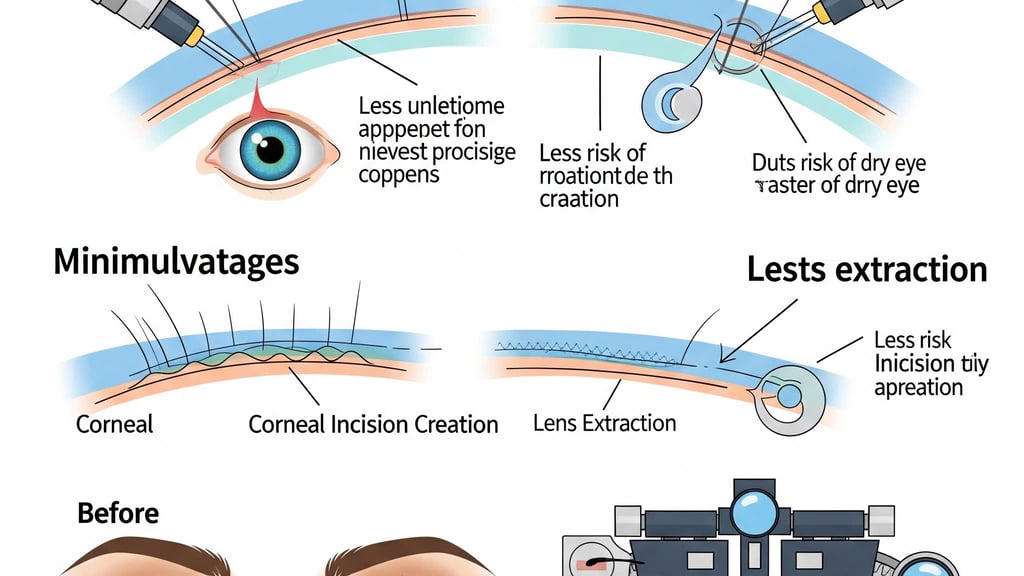ReLEx SMILE surgery - a new technology - When should myopia be operated on?
2/27/20257 min read


Introduction to Myopia
Myopia, commonly referred to as nearsightedness, is a prevalent vision condition that affects millions of individuals worldwide. It is characterized by the inability to see distant objects clearly, while close objects can be seen with relative ease. This refractive error occurs when the eyeball is too long or when the cornea has excessive curvature, leading to light entering the eye being focused in front of the retina, rather than directly on it. As a result, those with myopia may struggle with activities such as driving, watching television, or enjoying outdoor sports.
The global prevalence of myopia has increased significantly over the past few decades, with estimates suggesting that approximately 30% of the population is affected by this condition in Western countries, while that figure can be as high as 80-90% in certain Asian countries. This trend is concerning, particularly given the significant implications that myopia can have on overall quality of life. Symptoms of myopia often manifest in childhood and may progressively worsen during the teenage years when the eye continues to develop and grow. Many individuals report difficulties in focusing on distant objects and may experience related symptoms such as headaches and eye strain.
Several risk factors contribute to the development of myopia. Genetics play a crucial role, as individuals with a family history of nearsightedness are at a higher risk. Environmental factors, such as prolonged near-work activities like reading or screen time, and limited outdoor exposure, have also been identified as contributing factors to this vision problem. Early detection and appropriate management of myopia are essential for minimizing complications that may arise from untreated cases. If left unaddressed, myopia can lead to more severe eye conditions, including retinal detachment and glaucoma. Hence, understanding myopia and seeking timely intervention is critical for preserving vision health.
What is Relex Smile Surgery?
Relex Smile surgery, or ReLEx SMILE (Small Incision Lenticule Extraction), is an advanced laser eye surgery technique specifically designed to correct myopia, or nearsightedness. This innovative approach utilizes cutting-edge femtosecond laser technology to reshape the cornea, thereby improving visual acuity. Unlike conventional refractive surgeries such as LASIK, Relex Smile is distinguished by its minimally invasive methodology, which entails creating a small incision and removing a lenticule, a disc-shaped piece of corneal tissue.
The procedure begins with the application of anaesthetic drops, ensuring patient comfort throughout the process. The femtosecond laser then generates a precise refractive cut within the cornea, forming the lenticule. This cutting-edge approach eliminates the need for a corneal flap, as seen in the LASIK procedure. Consequently, the small incision used in Relex Smile results in reduced disruption to the corneal surface and a faster recovery time for patients.
One of the primary advantages of Relex Smile surgery is its reduced risk of complications associated with flap creation, which can arise during traditional LASIK procedures. Furthermore, patients often experience less postoperative discomfort and can resume normal daily activities sooner. Another benefit of this technique is its suitability for a broader range of patients, including those with higher degrees of myopia, who may not have been ideal candidates for earlier surgical options.
In comparison to traditional methods, Relex Smile surgery offers a more streamlined and efficient experience. As such, it represents a significant advancement in the field of refractive surgery, contributing to enhanced patient satisfaction and improved visual outcomes. With its minimal invasiveness and faster healing times, Relex Smile is poised to be a leading option for individuals seeking effective and lasting corrections to their vision.
When is Surgery Necessary for Myopia?
Myopia, commonly referred to as nearsightedness, is a prevalent refractive error that can significantly affect an individual’s quality of life. The necessity for surgical intervention, including Relex Smile surgery, is often determined by various factors related to the stage and severity of myopia. Understanding these criteria is essential for patients considering surgical options.
Myopia is typically classified into three categories: mild, moderate, and severe. Mild myopia generally does not interfere significantly with daily activities and can often be corrected with prescription glasses or contact lenses. Moderate myopia, while manageable, may begin to hinder daily performance and indicate that a corrective approach could be beneficial. Severe myopia, however, poses more considerable challenges and elevates the risk of associated ocular complications such as retinal detachment or glaucoma.
A key indicator that suggests the need for surgical intervention is the progression of myopia. Patients experiencing rapid deterioration in vision despite corrective measures may be recommended for surgery. In addition, individuals who rely heavily on their vision for occupational or recreational activities might benefit from surgical options when traditional methods prove insufficient or inconvenient.
Other considerations include the stability of one's prescription over a certain period, typically two years, as rapid changes can imply underlying health issues. It is important to note that candidacy for surgery is assessed on a case-by-case basis and considers the overall health of the eyes. A thorough evaluation by a specialized ophthalmologist is crucial in determining if Relex Smile surgery or other surgical methods are the most appropriate and safe options for treating myopia.
Benefits of Relex Smile Surgery
Relex Smile Surgery has emerged as a revolutionary method for treating myopia, offering numerous benefits to individuals seeking to improve their vision. One of the most significant advantages of this minimally invasive procedure is the enhanced visual acuity it can provide. Patients often experience a rapid improvement in their sight, which can lead to a better quality of life, allowing them to engage in daily activities with greater ease and clarity.
Another noteworthy aspect of Relex Smile Surgery is the minimal discomfort associated with recovery. Unlike traditional forms of vision correction, such as LASIK, Relex Smile utilizes a less traumatic approach that results in quicker healing times and less post-operative pain. Patients can expect to return to their regular activities within a short period, unlike other corrective methods that may require extensive downtime. This swift recovery process can be particularly beneficial for individuals with busy lifestyles or professional commitments.
Additionally, the long-term effectiveness of Relex Smile Surgery is compelling. Many patients enjoy stable vision correction for years following the procedure, significantly contributing to their satisfaction and confidence. This durability makes Relex Smile an appealing choice compared to traditional glasses or contact lenses, which may require regular updates or adjustments due to changes in vision over time.
In contrast, the potential downsides of not opting for Relex Smile Surgery or delaying corrective measures may include deteriorating eyesight, increased dependency on corrective lenses, and a diminished overall quality of life. For those grappling with myopia, finding an effective solution is crucial. Therefore, Relex Smile Surgery presents itself as a promising option that combines efficiency with patient comfort, ensuring that individuals can better manage their vision health in the long run.
Risks and Considerations
Relex Smile surgery, while a promising option for treating myopia, carries certain risks and considerations that potential candidates must evaluate. As with any surgical procedure, understanding these risks is crucial in making an informed decision. The most common complications associated with Relex Smile include temporary side effects such as dry eyes, glare, halos, or fluctuating vision, which may persist for a period post-surgery. These effects are typically temporary and can improve over time, but they highlight the importance of setting realistic expectations regarding postoperative recovery.
Additionally, there are more serious but less common risks that can occur, including corneal swelling, infection, or even a reduction in visual acuity. These complications may necessitate further treatment to mitigate their effects. It is essential that candidates engage in thorough discussions with their eye care professionals to understand the probability of these risks based on their specific circumstances, including their eye health and degree of myopia.
Furthermore, effective post-operative care is vital for a successful outcome. Patients must adhere to their surgeon’s instructions regarding recovery practices, which may include avoiding strenuous activities and using prescribed eye drops to facilitate healing. Regular follow-up appointments will be necessary to monitor the healing process, ensuring that any complications are addressed promptly.
In light of these considerations, it is paramount for individuals contemplating Relex Smile surgery to consult with a qualified eye care professional. An experienced practitioner can provide a comprehensive assessment, helping candidates weigh the benefits against the potential risks and guiding them towards achieving their vision correction goals safely and effectively.
The Procedure: What to Expect
On the day of your Relex Smile surgery, it is essential to be prepared for a seamless experience. The process begins with pre-operative assessments, which may include visual acuity tests and measurements of your eye shape and thickness. This series of examinations ensures that you are a suitable candidate for the Relex Smile procedure and allows the surgeon to plan the treatment effectively.
Once the assessments are completed, you will be briefed about the surgical process. The Relex Smile surgery typically takes approximately 20 to 30 minutes per eye. You will be positioned comfortably in a surgical chair, and your eyes will be numbed with topical anesthetic drops, ensuring you remain pain-free throughout the procedure. A specialized device will hold your eyelids open, allowing the surgeon easy access to your cornea.
During the actual surgery, a laser will create a small incision in the cornea, followed by the removal of a precise amount of tissue to reshape it. This step is crucial, as it corrects the refractive error, allowing for improved vision. Once the procedure is completed, a protective contact lens may be placed on your eye to promote healing.
Post-operative care is crucial for optimal recovery. After the surgery, you will be given instructions regarding follow-up appointments and care for your eyes. Typical recommendations include using prescribed eye drops to prevent infection and reduce inflammation, avoiding strenuous activities for a few days, and protecting your eyes from bright lights and irritants. Most patients experience a significant improvement in vision shortly after the procedure; however, complete recovery may take several days. Overall, understanding the steps involved in the Relex Smile surgery can alleviate any anxieties, allowing for a smoother experience on the day of your treatment.
Conclusion and Next Steps
Relex Smile surgery has emerged as a revolutionary treatment for myopia, offering a minimally invasive approach that appeals to many individuals seeking vision correction. Throughout this blog post, we have examined the innovative technology behind Relex Smile, the procedure's safety and efficacy, as well as the advantages it presents over traditional laser eye surgeries. Patients can benefit from reduced discomfort, quicker recovery times, and more precise outcomes, making this treatment an attractive option for those suffering from nearsightedness.
As myopia continues to affect a large portion of the population, understanding the various corrective measures available is essential for informed decision-making. It is crucial for individuals considering Relex Smile surgery to consult with an experienced eye care professional who specializes in this cutting-edge technique. A thorough discussion about personal vision needs, medical history, and any potential risks associated with the procedure can help ascertain whether Relex Smile is the appropriate choice.
To prepare for your consultation, consider compiling any questions you may have regarding the procedure, recovery timeline, and expected outcomes. Additionally, it is beneficial to gather information about your family’s eye health history, as hereditary factors may influence your treatment options. By approaching your consultation well-informed, you can engage in a productive dialogue with your eye care specialist, resulting in tailored advice suited to your specific situation.
For further reading, we recommend visiting reputable sources such as the American Academy of Ophthalmology and the Vision Council. These organizations provide comprehensive insights into the latest advancements in myopia treatment and additional resources that can enhance your understanding of Relex Smile surgery. By staying informed and prepared, you can take significant strides towards achieving clearer vision.
